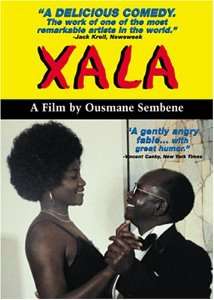Xala
| Xala | |
|---|---|
 DVD Cover | |
| Directed by | Ousmane Sembène |
| Produced by | Filmi Domireve SNC |
| Written by | Ousmane Sembène |
| Screenplay by | Ousmane Sembène |
| Starring |
Thierno Leye, Seune Samb, Douta Seck, Younousse Sèye, Fatim Diagne, Myriam Niang |
| Music by | Samba Diabara Samb |
| Cinematography | Georges Caristan Orlando L. López Seydina D. Saye Farba Seck |
| Edited by | Florence Eymon |
Production company |
Films Domireew Société Nationale Cinématographique |
| Distributed by | New Yorker Films (USA) |
Release date |
|
Running time | 123 minutes |
| Country | Senegal |
| Language |
French Wolof |
Xala (pronounced [ˈxala], Wolof for "temporary sexual impotence"[1]) is a 1975 Senegalese film directed by Ousmane Sembène. It is an adaptation of Sembène's 1973 novel of the same name. The film depicts El Hadji, a businessman in Senegal, who is cursed with crippling erectile dysfunction upon the day of his marriage to his third wife. The film satirizes the corruption in African post-independence governments; El Hadji's impotence symbolizes the failure of such governments to be useful at all.[2]
Plot
El Hadji Abdoukader Beye, a Senegalese businessman and a muslim, takes on a third wife, thereby demonstrating his social and economic success. On the wedding night he discovers that he is incapable of consummating the marriage; he has become impotent. At the beginning, he suspects that one or both of his first two wives have put the spell on him, without realizing that he walks by the true guilty party every day (beggars and people he has stolen from). The film criticizes the African leaders' attitude after Independence, underlining their greed and their inability to step away from foreign influences.[3]
Characters
- El Hadji Abdoukader Beye, a Senegalese businessman
- Rama, Beye's daughter with his first wife
- Adja Awa Astou, Beye's first wife
- Oumi Ndoye, the second wife
- Ngoné, the third wife
- Modu, El Hadji's chauffeur
- Sérigne Mada, a marabout
- The president of the chamber of commerce
- Dupont-Durand, the president's chaperone
Reception
Criticism
Scholar Aaron Mushengyezi writes: "I posit that in Xala, he evokes two problematic binary oppositions: between the corruption and decadence of foreign influence and the purity and morality of African tradition, the former represented as 'corrupting' and the latter 'redemptive'; and between strong, revolutionary 'masculine' women and villainous, weak, 'feminine' men." [4]
Another scholarly perspective is from Harriet D. Lyons: "I shall argue that in Sembene's work the "covertness" of the folk material takes the form of suppression of detail combined with the retention of essential values. Sembene is thereby able to use folk elements in such a way as to give the work political implications that go well beyond the preservation and/or revival of a local tradition. One can, therefore, examine the folk elements of Xala without fear of consigning yet another expression of African creativity to the museum of primitive art." [5]
Awards
The film was entered into the 9th Moscow International Film Festival.[6]
Festival Internacional de Cine de Karlovy Vary 1976
The film ranked #83 in Empire magazine's "The 100 Best Films Of World Cinema" in 2010.[7]
See also
References
- ↑ "Xala". filmreference.com. Retrieved 2012-08-11.
- ↑ Malcolm, Derek (21 December 2000). "Ousmane Sembene: Xala". Century of Films. The Guardian. Retrieved 2012-07-11.
- ↑ FCAT
- ↑ Mushengyezi, Aaron (2004). "Reimaging Gender and African Tradition? Ousmane Sembène's Xala Revisited". Africa Today. 51 (1): 47–62. doi:10.1353/at.2004.0070.
- ↑ Lyons, Harriet D. (1984). "The Uses of Ritual in Sembene's Xala". Canadian Journal of African Studies. 18 (2): 319–328. doi:10.2307/484332.
- ↑ "9th Moscow International Film Festival (1975)". MIFF. Archived from the original on January 16, 2013. Retrieved 2013-01-06.
- ↑ "The 100 Best Films Of World Cinema | 83. Xala". Empire. Retrieved 2012-07-11.
- African Film Festival of Cordoba-FCAT (license CC BY-SA)
External links